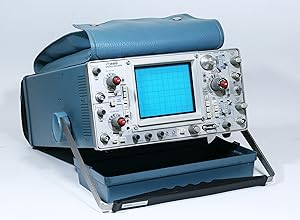Beschreibung
USED TO LAUNCH THE DIGITAL REVOLUTION, TWICE: This oscilloscope was used to design Pong, the birth of the video game industry, and the Apple II, the first personal computer with hi-res color graphics. The present oscilloscope is a remarkable artifact, having played a critical role in launching two of the most consequential products in the history of the digital revolution: Atari's Pong and the Apple II computer. Very few artifacts of comparable importance to the digital revolution have come to market. In 1970, Tektronix introduced the Tektronix 465, a powerful and portable transistorized oscilloscope that quickly became the standard instrument for digital logic designers. In 1972 Atari purchased a 465 - the very oscilloscope offered here - for their chief engineer, Al Alcorn. I. THIS OSCILLOSCOPE WAS USED BY AL ALCORN TO DESIGN THE GAME PONG: The introduction of Pong in 1972 marked the birth of the video game industry. Several years later, Wozniak and Alcorn became acquainted through Steve Jobs, who worked at Atari under Alcorn. "I hiredSteve Jobson a fluke, and he's not an engineer. His buddy Woz was working at HP, but we were a far more fun place to hang out. We had a production floor with about 30 to 50 arcade video games being shipped, and they were on the floor being burnt in. Jobs didn't get along with the other guys very well, so he'd work at night. Woz would come in and play while Jobs did his work, or got Woz to do it for him. And I enjoyed Woz. I mean, this guy is a genius, I mean, a savant." (Al Alcorn in IEEE Spectrum, April 2020). Later, in 1976, Alcorn loaned his Tektronix 465 to Wozniak while Wozniak was designing the Apple II. II. THIS OSCILLOSCOPE WAS CRITICAL TO ACHIEVING ONE OF APPLE II'S MOST CONSEQUENTIAL FEATURES: HIGH RESOLUTION COLOR GRAPHICS. The Apple II was revolutionary in part because it displayed high resolution color graphics when connected to a color television set. To accomplish this, Wozniak used a trick for exploiting the NTSC color system built into color tv sets. Woz learned this trick from Alcorn: "I actually loaned them my oscilloscope, I had a 465 Tektronix scope, which I still have, and they designed the Apple II with it. I designedPongwith it. I did some work, I think, on the [audio] cassette storage. And then I remember showing Woz the trick for the hi-res color, explaining, sitting him down and saying, "Okay, this is how NTSC issupposedto work." And then I said, "Okay. Now therealityis that if you do everything at this clock [frequency] and you dothiswith a pulse of square waves." And basically explained the trick. And he ran with it. That was the tradition. I mean, it was cool. I was kind of showing off!" (Alcorn, IEEE Spectrum, April 2020). The Apple II revolutionized the computer industry in large part precisely because it had color graphics and supported video game play. But before the Apple II could launch the PC revolution, Apple needed resources to transition from the Apple I and the hobbyist market into the broader consumer market. III. WOZNIAK'S HIGH RESOLUTION COLOR GRAPHICS WERE CRITICAL TO APPLE'S LAUNCH. Even before the Apple II made a huge impact in the consumer market, Wozniak's revolutionary graphical display was critically important in simply getting Apple launched as a viable business. The Apple I had been a very modest success, but Jobs and Wozniak needed money to move forward with the Apple II, a product intended for ordinary consumers. Jobs initially asked Alcorn and Nolan Bushnell, Atari's co-founder, to invest. Both declined and instead referred Jobs to Don Valentine, one of Atari's earliest backers. Valentine also declined. But Valentine did put Jobs in touch with Mike Markkula, a wealthy 34 year old former engineer and marketing executive who had recently retired from Intel. Markkula was unimpressed by the Apple I, but when he saw the Apple II, and particularly the color graphics display, his view of Jobs and Wozniak changed dramatically: "Small computers lik. Bestandsnummer des Verkäufers 2732
Verkäufer kontaktieren
Diesen Artikel melden
![]()



